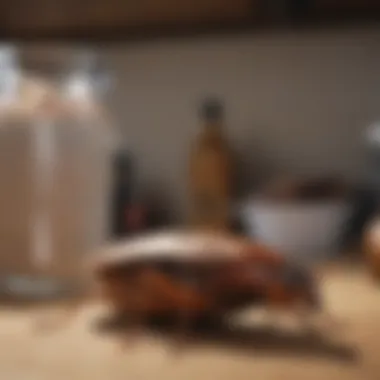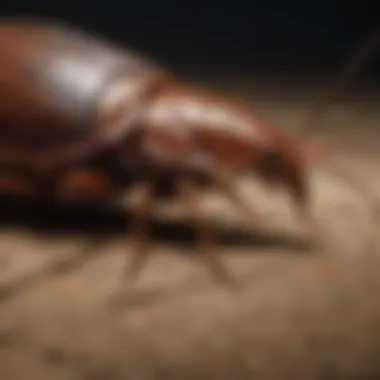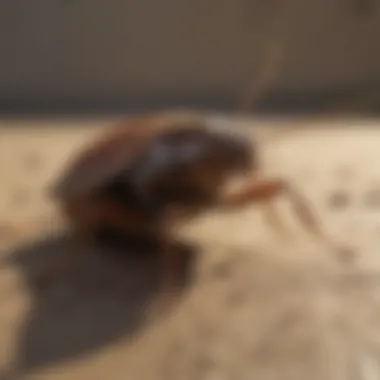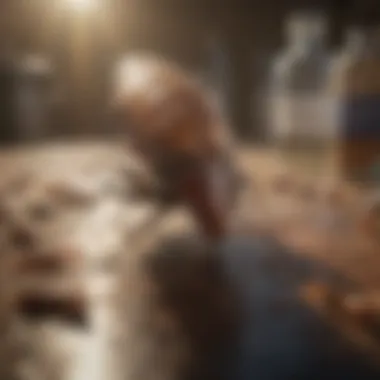Effective Strategies to Eliminate German Cockroaches


Intro
German cockroaches are a significant concern for many households. Understanding their behaviors and effective methods for control is crucial. This guide will provide valuable insights on how to identify, prevent, and eliminate these pests. With both chemical and non-chemical strategies discussed, this resource aims to help homeowners and pest management professionals alike.
Understanding Pests
Definition of Pests
Pests are organisms that harm human interests. They can affect health, property, and comfort. German cockroaches, in particular, are notorious for their rapid reproduction and adaptability. Their presence can indicate poor sanitation and can lead to food contamination.
Importance of Pest Identification
Correctly identifying a pest is essential for effective management. German cockroaches can be mistaken for other similar species. Knowing their physical characteristics and habitats helps in deploying the right strategies. Adult German cockroaches are light brown with two dark parallel stripes on their backs. Identifying their presence accurately is thus vital for efficient control measures.
Prevention Techniques
Home and Garden Preventative Measures
Preventing German cockroaches involves first eliminating their sources of food and shelter. Here are some effective measures:
- Keep surfaces clean: Regularly wipe down counters, tables, and other areas to remove crumbs and spills.
- Seal cracks and crevices: This reduces entry points and potential shelters for cockroaches.
- Store food properly: Use airtight containers to lower the chances of food contamination.
Seasonal Prevention Tips
Different seasons can bring varying challenges. During warmer months, cockroaches may become more active. Implement these seasonal tips:
- Inspect for leaks: Ensure all areas, especially kitchens and bathrooms, are dry and free from leaks.
- Regular inspections: Check for signs of infestation in warmer months, taking quick action if found.
Eco-Friendly Pest Control Solutions
Overview of Sustainable Practices
Sustainable pest control focuses on methods that minimize harm to the environment. Integrated Pest Management (IPM) is a common approach.
- Monitor: Regularly check for signs of pests without the immediate use of pesticides.
- Control: Implement multiple strategies to manage pests sustainably.
Natural Remedies and Their Effectiveness
Many natural remedies can deter cockroaches. These include:
- Boric acid: Safe when used correctly; it disrupts the cockroach's digestive system.
- Diatomaceous earth: A natural substance that dehydrates and kills pests upon contact.
"An ounce of prevention is worth a pound of cure. Regular maintenance and monitoring can save you from severe infestations later."
Implementing these strategies is essential for effective control of German cockroaches. Homeowners should adopt a proactive approach to manage their environment and reduce the likelihood of an infestation.
Understanding German Cockroaches
Understanding German cockroaches is vital for anyone dealing with pest control in their homes. These pests are not just unsightly; they pose health risks, contaminate food, and induce allergies. In this article, we will discuss various aspects of German cockroaches that contribute to their management. Knowledge of their biology, behavior, and life cycle is essential in devising effective elimination strategies. This foundational understanding aids both homeowners and pest control professionals in recognizing infestations early, choosing appropriate control measures, and preventing future occurrences.
Biology and Life Cycle
Eggs and Nymphs
German cockroaches reproduce rapidly, making their eggs and nymphs critical to recognize. A single female can produce up to 40 eggs at once, encased in a protective ootheca. These eggs hatch into nymphs in about a month. The nymphs are particularly alarming because they resemble adults but lack wings and are smaller. Their mobility and rapid growth cycle allow infestations to escalate quickly. Being aware of the egg cases or live nymphs helps in understanding how quickly a single roach can lead to a larger problem.
Adult Characteristics
The adult German cockroach is about 1.5 to 2 inches long and identifiable by its light brown color and two dark stripes on its thorax. Their physical ability to hide in tight spaces and their nocturnal behavior are key traits that contribute to their establishment in households. Adults are more challenging to eliminate compared to nymphs and eggs, as they are adept at avoiding traps and insecticides. This characteristic necessitates a combination of different pest control strategies, optimizing the chances for complete eradication.
Reproduction Rates
German cockroaches have one of the highest reproduction rates among household pests. They can reproduce every few weeks, increasing in number swiftly under favorable conditions. This prolific nature makes them difficult to control once a population takes hold. Understanding their reproduction rates highlights the urgency in addressing even small infestations. Regular monitoring and swift action can mitigate the risks posed by these fast-multiplying pests.


Behavioral Traits
Habitat Preferences
German cockroaches prefer warm, moist environments where food is readily available. They are commonly found in kitchens and bathrooms, particularly in cracks, crevices, and behind appliances. Recognizing these preferred habitats can direct control efforts to the right locations. This knowledge assists in targeting cleaning and treatment measures, ultimately reducing the chances for roach habitation in homes.
Feeding Habits
The feeding habits of German cockroaches are another significant aspect to consider. They are omnivores and will eat a variety of substances, including food remnants, greasy surfaces, and even book bindings. This adaptability makes them especially troublesome in kitchens. Keeping surfaces clean and food stored properly can limit food sources and reduce their presence.
Social Behavior
German cockroaches exhibit interesting social behaviors, often clustering in groups. They communicate through pheromones and can often be found in high-density areas. This social nature can help in both identification and control strategies, as targeted treatments in affected areas can disrupt their habitats and limit their spread. Recognizing this aspect can also emphasize the importance of immediate action when an infestation is suspected.
Identifying Infestations
Identifying infestations of German cockroaches is crucial for effective pest management. Early detection is key to preventing a full-blown infestation. When you recognize the signs early, you can take targeted action before the population gets too large. Knowing what to look for enables homeowners to act quickly, minimizing damage and maintaining a hygienic living environment.
Signs of Infestation
Visual Sightings
Visual sightings of German cockroaches are the first indicator of an infestation. A single roach may not seem alarming, but it is important to recognize that these pests reproduce rapidly. Observing adult roaches, especially at night, suggests a significant presence. The distinctive appearance of German cockroaches—with their light brown color and two dark stripes on their backs—makes them easier to identify.
The uniqueness of visual sightings lies in their immediate clarity; seeing a cockroach directly means an urgent response is necessary. The disadvantage is that they are often elusive, hiding when disturbed, which may delay detection until the problem worsens.
Increased Droppings
Increased droppings are another telltale sign of an infestation. Roach droppings resemble small, dark brown or black specks, often found in areas where they travel. These droppings can be located near food sources or nesting sites, indicating the extent of the infestation.
The presence of droppings is beneficial for pinpointing areas of concern. It helps in focusing efforts on specific locations within your home. However, relying solely on droppings without addressing the source may lead to ongoing problems.
Foul Odors
Foul odors are a consequence of a significant infestation. As German cockroaches produce and secrete waste, odors can become noticeable, especially in localized areas. The scent tends to be musty or oily, which can give away their hiding spots.
This unique characteristic serves as a vital clue, particularly during nighttime when visibility is low. While odors can be helpful in identifying issues, they are often an indication of a larger problem, requiring immediate action to mitigate.
Common Hiding Spots
Kitchen Areas
Kitchen areas are prime locations for German cockroach infestations. The presence of food, moisture, and warmth creates an ideal habitat. These roaches are nocturnal and often venture out when kitchens are less active. Hidden corners, under appliances, or within cabinets are common hiding spots.
This significant characteristic makes kitchens high-risk zones. Regular inspection and sanitation are essential. The primary disadvantage is that kitchens also provide many access points, which can complicate control measures.
Bathrooms
Bathrooms are another common hiding spot for these pests due to the humid conditions. Roaches often hide in sinks, around pipes, and under vanities. The darkness and moisture provide a perfect environment for their survival.
The key advantage here is that regular bathroom cleaning can help in spotting early signs of an infestation. However, if moisture is not adequately controlled, these areas can continue to attract roaches, creating ongoing issues.
Basements
Basements are frequently dark and less inhabited, making them attractive for German cockroaches. They can thrive in clutter, feeding on organic matter found in boxes or garbage. Basements often have moisture problems, further enhancing their appeal.
The unique feature about basements is that they are often overlooked during regular cleaning, making it easier for infestations to grow. The disadvantage is that if a problem develops unnoticed, it may require more intensive measures to eradicate the roaches.
To sum up, identifying infestations is the first step in managing German cockroaches effectively. Recognizing visual signs, droppings, and odors, along with understanding common hiding spots, is essential for homeowners seeking to maintain a pest-free home.
Prevention Techniques
Preventing an infestation is central to effective pest management, especially when dealing with German cockroaches. This section details key practices that hinder the establishment and proliferation of these pests within your home. The goal is to create an environment that is less welcoming to cockroaches, ultimately leading to a wood-sized habitat reduction.


Sanitation Practices
Regular Cleaning
Regular cleaning plays a crucial role in preventing German cockroach infestation. By maintaining a tidy home, people can reduce shelter and food sources for these pests. The diligent practice of cleaning areas where food is prepared or consumed limits the chances of attracting cockroaches. A key characteristic of regular cleaning is that it is systematic—targeting areas that are often neglected, such as behind appliances or under sinks. This method, while straightforward, is exceptionally beneficial as it not only reduces food sources but also unearths potential pest entry points. Continuous implementation promotes long-term effectiveness.
Food Storage
Food storage strategies significantly bolster efforts against the presence of German cockroaches. One of the essentials is storing food in airtight containers. This method effectively restricts access to food, a primary attraction for cockroaches. Utilizing glass or plastic containers with secure lids is ideal, thus preventing contaminants from reaching inside. The attractive feature of such practices lies in their simplicity and low-cost nature. The downside could be that caregivers sometimes overlook proper sealing, allowing access to pests still.
Garbage Management
Effective garbage management is inherently tied to pest control. Keeping trash covered and disposing of it regularly is necessary to deter German cockroaches. This aspect emphasizes the need for lidded bins, which minimize odor that flies can detect. One of its key traits is the establishment of a set routine for waste disposal, ensuring no food remains are present to attract pests. However, failing to maintain a consistent garbage routine can lead to an immediate risk of infestation.
Home Modifications
Sealing Cracks and Crevices
Sealing cracks and crevices represents a critical step in preventing German cockroach entry. This involves inspecting and mitigating any points of entry, such as gaps along baseboards, windows, and doorways. A significant characteristic of this approach is its straightforward nature. Homeowners can typically manage this maintenance using caulk or foam sealant. The unique advantage lies in its preventive nature, which can be seen as a one-time investment contributing to long-term results. Concerns may arise regarding the durability of the seal, particularly in high-traffic areas.
Repairing Leaks
Repairing leaks stands as another vital home modification tactic. Cockroaches thrive in moist environments. Therefore, fixing leaking faucets and pipes eliminates water sources that attract these pests. The characteristic appeal of this strategy is that it not only deters pests but also conserves water, aligning with eco-friendly home practices. The downside may be the necessity for timely action. Unaddressed leaks can quickly turn from minor annoyances into significant pest attractions.
Controlling Humidity
Controlling humidity effectively helps to manage the living conditions that favor German cockroaches. Maintaining a humidity level below 50% can deter cockroach activity. This can be done using dehumidifiers or proper ventilation systems. The essential feature of this method is its proactive nature. By ensuring the home environment is inhospitable, residents reduce the likelihood of infestation. However, initial setup costs for dehumidifiers can be seen as a disadvantage for some homeowners.
Control Methods
Understanding control methods is crucial to effectively eliminate German cockroaches. They are resilient pests that can quickly lead to extensive infestations. A combination of chemical and non-chemical control methods can provide a more comprehensive approach to managing these insects. This section discusses various strategies, highlighting their benefits and considerations.
Chemical Control
Insecticide Types
Insecticides play a significant role in cockroach control. Common types include pyrethroids, insect growth regulators, and organophosphates. Pyrethroids are popular due to their quick action. They disrupt the nervous system of cockroaches, providing rapid results. Organophosphates, on the other hand, are effective on a broader range of insects but require careful application. Each type has its unique attributes that cater to different infestations.
However, over-reliance on insecticides can lead to resistance, reducing their effectiveness over time.
Application Techniques
Application techniques are essential to maximize the effectiveness of insecticides. Methods such as spraying, baiting, and dusting are commonly used. Spraying offers quick coverage in accessible areas, while baiting focuses on attracting cockroaches to a lethal food source. Dusting allows treatment of hard-to-reach spaces.
Each technique has its advantages; baiting is particularly effective in reducing populations by targeting the social behavior of cockroaches. Yet, incorrect application might lead to poor results, highlighting the importance of following manufacturer guidelines closely.
Safety Precautions
Implementing safety precautions when using chemical controls is paramount. These involve proper use of personal protective equipment, ensuring good ventilation, and following label directions.
Chemicals can pose health risks to pets and humans. Misapplications can lead to contamination and exposure. Thus, understanding and adhering to safety measures reduces the likelihood of adverse effects during treatment.
Non-Chemical Control
Boric Acid
Boric acid is a widely used non-chemical option for controlling cockroaches. Its effectiveness lies in its desiccating properties, which damage the cockroach’s exoskeleton. This leads to dehydration. Furthermore, it is considered safer for homes with children and pets compared to traditional pesticides.
However, boric acid must be placed carefully to avoid unintentional ingestion and can be less effective if not applied appropriately.
Traps and Baits
Using traps and baits is another effective non-chemical control strategy. Glue traps capture cockroaches without chemicals, allowing for monitoring and reducing populations. Baits, particularly those containing hydramethylnon or fipronil, appeal to cockroaches, leading them to take the poison back to their nests.


While traps provide a visual assessment of infestation levels, they may not always eliminate the entire population on their own.
Essential Oils
Essential oils, such as peppermint and tea tree oil, have gained attention as potential repellents. They disrupt the pheromone trails that cockroaches use for navigation. This can be a helpful deterrent in preventing infestations.
Nevertheless, while they are more environmentally friendly options, their efficacy is generally lower compared to traditional insecticides. Therefore, they are best used as complementary measures.
Integrated Pest Management
Combining Approaches
An integrated approach combines all methods discussed above to maximize effectiveness. This strategy allows for adaptation based on the severity of the infestation and specific household conditions. By mixing chemical and non-chemical controls, one can address immediate threats while also considering long-term management.
The key to successful integration is understanding the strengths and weaknesses of each method and using them synergistically.
Monitoring and Evaluation
Ongoing monitoring is crucial to assess the efficacy of chosen control methods. Regular checks can identify re-infestations quickly, allowing for timely intervention. Evaluating treatments ensures that ineffective methods do not linger in the pest management plan.
This continuous assessment also provides insights into cost-effectiveness and overall success.
Adapting Strategies
Adapting strategies is essential for long-term pest management success. Learning from assessment results will lead to adjustments in the control methods employed. If certain approaches lack efficacy, substitutions must be made.
This flexible mindset fosters a better environment for managing cockroaches, adapting to their resilient nature.
Long-Term Solutions
Long-term solutions for eliminating German cockroaches are essential for effective pest management. These strategies ensure that the problem does not just get treated temporarily but that it can be managed sustainably over time. The importance of long-term solutions lies in their ability to prevent re-infestations and reduce the likelihood of future outbreaks. Long-term planning involves a multi-faceted approach that combines monitoring, professional assistance, and education, facilitating a healthier living environment.
Continued Monitoring
Continued monitoring is a crucial element in the long-term management of German cockroaches. It goes beyond immediate extermination and focuses on maintaining a pest-free home in the long run.
Regular Inspections
Regular inspections are a key practice in identifying signs of cockroach activity early. This method is beneficial because it allows homeowners or pest control professionals to catch infestations before they escalate. The key characteristic of regular inspections is their proactive nature. Rather than waiting for visible signs of a problem, regular checks provide a comprehensive overview of a household's pest status. This ongoing vigilance can significantly reduce potential damage caused by roaches. One unique feature of regular inspections is that they can also identify conducive conditions that invite cockroaches into homes, such as moisture or food sources left out. The advantage of regular inspections is the ability to maintain control, while the disadvantage can be the time and effort required to carry them out consistently.
Assessment of Treatment Efficacy
Assessment of treatment efficacy involves evaluating how well the strategies in place are working against German cockroaches. This process is essential as it helps to determine if the methods used are effective or if adjustments are needed. The key aspect of this assessment is feedback. By analyzing pest numbers and behavior after implementation of various treatments, homeowners can make informed decisions. This approach is popular because it is data-driven and can lead to more effective pest management strategies. A unique feature of this assessment is its focus on non-chemical control methods, as well as chemical methods, providing a comprehensive evaluation of all approaches. One of the main advantages is the ability to refine control techniques over time for better results while a disadvantage might be the complexity in tracking every detail of treatment effectiveness.
Engaging Pest Control Professionals
Engaging with pest control professionals can often be the best decision for households dealing with persistent German cockroach problems. These specialists offer expertise that can result in improved outcomes compared to DIY methods.
When to Seek Help
Knowing when to seek professional help is critical. If a household faces repeated infestations despite personal efforts, this might be a clear indication that professional assistance is necessary. The key characteristic of this scenario is recognizing the limits of DIY strategies. It is advantageous to seek help to access specialized tools and knowledge. One unique feature of involving professionals is their ability to propose tailored solutions based on specific situations or infestations, leading to faster resolution. However, a disadvantage is the associated costs that may arise when bringing in experts.
What to Expect from Professionals
When engaging pest control professionals, it is essential to understand what to expect from them. Professionals will typically conduct a thorough inspection to identify problem areas, followed by a discussion of potential treatment options. The key defining quality of professional engagement is their systematic approach and use of advanced methods. This practice is beneficial as it provides effective solutions tailored to specific situations. Also, professionals can offer a detailed plan, including monitoring after treatments, to ensure long-term success. One unique feature of professional engagement is their follow-up checks, which provide a layer of assurance. The downside might be that their methods may involve chemicals that some homeowners might prefer to avoid due to personal reasons.
Cost Considerations
Cost considerations are an important aspect when deciding to engage pest control services. Understanding the potential investment needed can help homeowners prepare financially. The key characteristic here is budgeting, which ensures that pest control measures are feasible. This consideration is beneficial because it allows for planning and a better understanding of the financial landscape of pest control. A unique feature of this assessment is that various services may offer different packages, helping in identifying the most cost-effective options. However, one disadvantage could be that some higher-end services may not be necessary for every situation, thus causing unnecessary expenditure.
Educating Household Members
Education is pivotal in achieving long-term solutions to German cockroach issues. Informed household members contribute significantly to a pest-free environment.
Importance of Awareness
The importance of awareness cannot be understated; understanding the pest's behavior, signs of infestation, and preventive measures plays an essential role in pest management. The key characteristic of awareness is its preventive nature. By being informed, individuals can take proactive steps to reduce cockroach risks. This educational aspect is beneficial as it fosters an environment of cooperation among residents. A unique feature of awareness is that it empowers all members of a household, particularly children, to contribute to hygiene practices and pest monitoring. On the downside, lack of engagement from any household members can dilute the effectiveness of the awareness initiatives.
Best Practices for All
Implementing best practices is a practical extension of awareness about German cockroaches. These practices include routine cleaning, proper food storage, and timely garbage disposal. The key quality of these best practices is their simplicity. They can be easily adapted to any home, promoting good hygiene. These practices are popular amongst households because they not only combat roaches but also enhance overall living conditions. A unique feature is their ability to serve as a foundation for pest management. While the advantages are numerous, an initial effort is required to establish these habits, which can sometimes be a hurdle for families.



